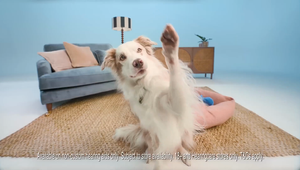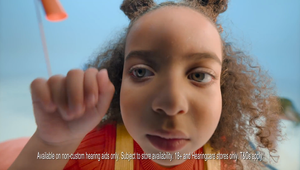
Become A Tiger Protector In JWT's New Campaign For WWF UK

WWF-UK brings the plight of wild tigers home in the latest ad to hit screens during this festive season, featuring a CGI enhanced injured Tiger with a doting family. The launch will also include a personalised book for children by award winning kids author Jeanne Willis and illustrator Jenni Desmond, which will be sent to donators after they have made their contribution.
Created by J. Walter Thompson London and called #iProtectTigers, the strategy moves away from the traditional “adopt a” mechanic where the charity protects the animal with money from donations and puts the power in the people’s hands by offering them the chance to do the protecting themselves as Tiger Protectors. WWF-UK’s touching ad launches at a critical time, less than one week from the mid-point of a 12-year global goal to double wild tiger numbers by 2022.
The J. Walter Thompson London creation, directed by the award winning Martin Stirling and using CGI from MPC, who have produced films including Disney’s Jungle Book, WWF-UK’s ‘Tiger in Suburbia’ will preview on E4 this weekend (19th) during Rise of the Planet of the Apes.
Jasper Shelbourne, Creative Director at J. Walter Thompson London, comments: “By making people Tiger Protectors we are bringing the audience much closer to the action, something manifested in the book, film and print. And, executionally there is something uniquely engaging about a 700lb Tiger in a small bedroom in suburbia.”
Highlighting the devastating impacts of the illegal wildlife trade, ‘Tiger in Suburbia’ features a CGI wild tiger which appears in need of urgent care after being caught in a poacher’s snare. The family nurse the tiger back to health in their home before it disappears back into the forest, sending a message that we in the UK can help protect wild tigers. Viewers are encouraged to sign up to be ‘Tiger Protectors’ as part of an integrated campaign #iProtectTigers.
Designed as a gift for children, the book can be fully personalised with the child’s name, gender, skin and hair colour. The parent role can also be personalised. It was written by Jeanne Willis, author of such titles as Chicken Clicking and the Penguin Pandemonium series and illustrated by Jenni Desmond, award winning creator of The Blue Whale. The pair have worked on a number of books together previously, including The First Slodge.
Kerry Blackstock, Director of Public Fundraising at WWF-UK, comments: “During the last century over 95% of the world's wild tiger population has been lost, with as few as 3,200 estimated in 2010 – an all-time low. Now their numbers have begun to increase, and we need to take this chance to secure their future. Protecting wild tigers and tackling the illegal wildlife trade is a topic close to the hearts of many people here in the UK. This advert acts as a stark reminder that although we may feel a million miles away from this issue, we can help. We can make a difference.
This Christmas campaign is a first for WWF-UK, using the power and magic of CGI to illustrate the plight of this endangered species. ”
WWF-UK’s #iProtectTigers campaign is part of the wider Tx2 goal to double the number of wild tigers by 2022. By donating £5 a month to become a ‘Tiger Protector,’ supporters can receive a personalised storybook along with updates throughout the year.
In 2010, governments of the 13 tiger range countries, together with organisations including WWF, set an ambitious and visionary conservation goal, to double the number of wild tigers by 2022 – the next Chinese year of the tiger. This goal is called Tx2.
Earlier this year conservationists worldwide celebrated a small victory as global wild tiger numbers were reported to have increased for the first time in conservation history. Yet with only around 3,900 tigers left in the wild, it is vital efforts are increased. NGOs, governments and local communities must build on this momentum to secure and increase wild tiger populations across Asian tiger range states.
Commenting on the campaign, Matteo La Motta, VFX Supervisor 3D, MPC said: "Although it sounds ridiculous, we started by using a life-sized toy tiger on the shoot to bring it to life. As well as capturing lighting references and shadows, this gave the actors their sight lines, and helped them to react accurately in the presence of an enormous animal. When it came to crafting the creature in CG, we used references of real tigers to animate its different expressions and movements, for example when he is in pain, sleeping, or walking down the stairs.
"It’s a real challenge to maintain the realism and believability of a 700lb tiger. We do creature work all the time, but this spot was particularly challenging because the animal is taken out of context – or its natural environment - and placed in a small, human and domestic space. To make sure we achieved total accuracy with the light, for example casting the correct shadows, we rebuilt the entire house in CG, paying particularly close attention to the bed to make sure it responds to the tiger's weight and movement."
Craig Hunt and James Humphreys, Creatives, J. Walter Thompson, London said: "Most people are aware that tiger numbers are worrying low. But it's a problem in a faraway land and they often feel they can't really make a difference. We wanted to change that by bringing the plight of the tigers closer to home, to empower people and make them realise that they can personally help protect tigers. Our idea literally brought the plight of the tigers home.
"We called it 'A Tiger In Suburbia' - the story of a normal family nursing a 700lb Bengal tiger back to health in their normal suburban home. We wanted to create an emotional story that people couldn't help engage with. And we took inspiration from another film where a family helps a foreign species get back home called - E.T. Although our Elliot was a girl called Isabell. Once we had our story we decided to bring it to life with a photomatic featuring Craig and his family, at the family home, and comped in tigers after. Even the simple photomatic had a real power to it and played a large part in winning the pitch. Our brave clients then confidently told us to go ahead and make the photomatic for real. And so we did."
















